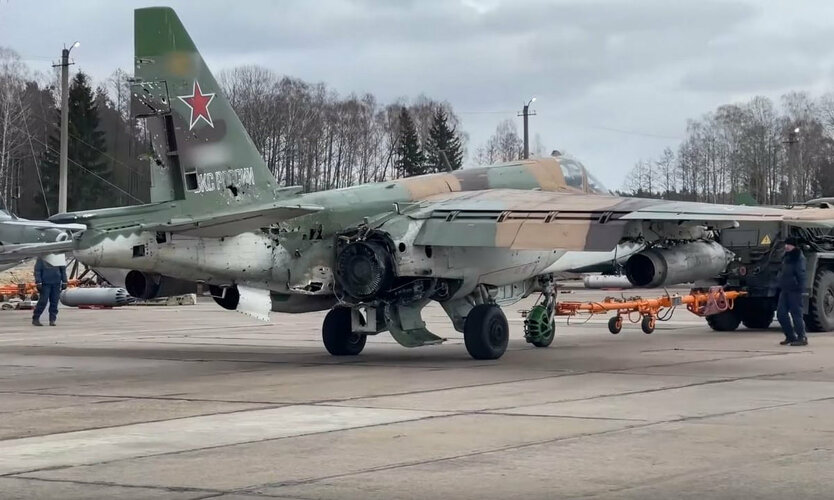Su-25SM3 is supposed to get partial Vitebsk complex integration. Passive stuff like MAWS integrated, active stuff like DIRCM turrets is possible to be carried in form of pod. Imho not great setup, but as it is. Plus in any case downed Su-25 was of older kind.I think people undervalue the Manpad threat. The US will generally not fly if there is a credible Manpad threat. It's very hard to be alerted. MAWS gear is typically not that great, so someone needs to get an eye on it. And the pilot has to quickly integrate what he knows from MAWS or someone else into a plan of action.
Saudis had an F-15 get hit a few weeks ago. Same story.
DIRCM mitigates this somewhat now but they are fairly expensive and large systems in most cases so it's not an ideal solution for lighter (compared to a C-17 or KC-135 or what have you) tactical aircraft like the Su-25 or F-15.
You are using an out of date browser. It may not display this or other websites correctly.
You should upgrade or use an alternative browser.
You should upgrade or use an alternative browser.
Sukhoi Su-25
- Thread starter Orionblamblam
- Start date
haavarla
ACCESS: Secret
- Joined
- 29 June 2010
- Messages
- 200
- Reaction score
- 253
Sorry for the necromancer of this thread.
But i just saw this Su-25 arguing with a Manpad
View: https://youtu.be/C0TIDaU2MsI
Su-25 Pilot be like;
Dude! let me finnish my run first, and i get right back to you
But i just saw this Su-25 arguing with a Manpad
Su-25 Pilot be like;
Dude! let me finnish my run first, and i get right back to you
Avimimus
ACCESS: Top Secret
- Joined
- 15 December 2007
- Messages
- 2,426
- Reaction score
- 909
If the reports are accurate it would appear that almost all of the known fixed-wing losses are Su-25. I can't help but to wonder what this says about the overall concept (of the A-10 too) and if this might lead to upgrades for the remaining aircraft or their withdrawal (except possibly for use in COIN operations).
The known proposed successor designs seem to have less armour and be geared towards operating at higher altitudes (note that Russians show a tendency towards some armouring of strike aircraft generally).
The known proposed successor designs seem to have less armour and be geared towards operating at higher altitudes (note that Russians show a tendency towards some armouring of strike aircraft generally).
Ainen
I really should change my personal text
- Joined
- 25 August 2011
- Messages
- 1,284
- Reaction score
- 1,725
They aren't doing that bad either apparently, considering the density of ad bubbles. Especially Ukrainian ones, as odds are heavily against them.
I.e. they're suffering losses, but that's a major conflict of the type no one has seen for quite a while.
I.e. they're suffering losses, but that's a major conflict of the type no one has seen for quite a while.
- Joined
- 19 July 2016
- Messages
- 4,279
- Reaction score
- 3,464
I think a lot of the replacements for these and other similar types will be of the drone variety myself, they already have a useful utility as a class of aircraft.
aonestudio
I really should change my personal text
- Joined
- 11 March 2018
- Messages
- 2,964
- Reaction score
- 7,493
Last edited by a moderator:
- Joined
- 11 February 2010
- Messages
- 1,650
- Reaction score
- 2,703
This kinda bring me into a question on those Su-25's which does not make it back.. I wonder what system that took them out. Must have been bigger than manpads. e.g Buk.
It’s not a guarantee that even a hardened airframe like the Su-25 will always survive a MANPADS hit, as warhead fragmentation patterns aren’t 100% consistent. It does improve the odds, however.
- Joined
- 1 April 2006
- Messages
- 11,397
- Reaction score
- 10,314
Фюзеляж самолета Су-25
Фюзеляж самолета Су-25 - Конструкция и проектирование летательных аппаратов. Фюзеляж
aonestudio
I really should change my personal text
- Joined
- 11 March 2018
- Messages
- 2,964
- Reaction score
- 7,493
View: https://twitter.com/UAWeapons/status/1584127900663496705

Fighterbomber
Хроники истребителя-бомбардировщика в отставке. Связь: @fbsha ✉ kab1500lg@gmail.com
Last edited:
- Joined
- 13 August 2007
- Messages
- 8,451
- Reaction score
- 11,024
I know it's Ukraine war but this here is unique footage
how Aircraft is shot down from Pilot perspective
View: https://twitter.com/CaptainBlackSe1/status/1584147920613306368
how Aircraft is shot down from Pilot perspective
View: https://twitter.com/CaptainBlackSe1/status/1584147920613306368
- Joined
- 18 June 2009
- Messages
- 1,412
- Reaction score
- 2,494
hagaricus
ACCESS: Barclaycard
- Joined
- 5 November 2010
- Messages
- 177
- Reaction score
- 172
Apparently it was a powerline strike near Belgorod, Russia, in June.
View: https://twitter.com/rubenhofs/status/1584290713977880577
View: https://twitter.com/rubenhofs/status/1584290713977880577
Last edited:
Conspirator
CLEARANCE: L5
- Joined
- 14 January 2021
- Messages
- 324
- Reaction score
- 230
I have suddenly come across this footage of possibly the first recorded Ejection in an active combat zone. And wanted to find out as much information as possible on the particular subject.
What we know :
The Aircraft was a SU-25 Frogfoot known as Red 9 based on the footage. There are only two of these aircraft bearing this marking. Su-25SM RF-91965 and Su-25SM3 RF-93025. And based on the footage it was also an SM3 upgrade. Not much is known about the incident specifically but my thoughts are most likely a MANPADS system.
If anyone can find any information on this incident. Please feel free to post it here.

 www.thedrive.com
www.thedrive.com
View: https://youtu.be/qkT7Q5EHOAc
What we know :
The Aircraft was a SU-25 Frogfoot known as Red 9 based on the footage. There are only two of these aircraft bearing this marking. Su-25SM RF-91965 and Su-25SM3 RF-93025. And based on the footage it was also an SM3 upgrade. Not much is known about the incident specifically but my thoughts are most likely a MANPADS system.
If anyone can find any information on this incident. Please feel free to post it here.

Russian Pilot's Ejection From An Su-25 Seen In Incredible Headcam Video
The incredibly violent action sequence of a Russian Su-25 Frogfoot pilot ejecting looks like something out of a video game, but it's not.
Last edited:
A bit surprised to see him stationary where he landed, although it looked like he hit hard, not much time for a proper PLF. Must be on his side of the line or hurt, because I would release, grab the kit and get some cover…View: https://www.youtube.com/watch?v=2egPbv7JU9g
View: https://twitter.com/UAWeapons/status/1584127900663496705

Fighterbomber
Хроники истребителя-бомбардировщика в отставке. Связь: @fbsha ✉ kab1500lg@gmail.comt.me
- Joined
- 29 November 2010
- Messages
- 1,775
- Reaction score
- 3,479
Ukraine weapons tracker has since confirmed that it was not brought down over Ukraine
but was a flying accident within Russia
but was a flying accident within Russia
Thanks @helmutkohl, in that case makes total sense to stay where you can be found quickly.Ukraine weapons tracker has since confirmed that it was not brought down over Ukraine
but was a flying accident within Russia
- Joined
- 29 November 2010
- Messages
- 1,775
- Reaction score
- 3,479
same.. when I first saw the video.. I was wondering why he didn't seem to panic or rush away from the crash site.Thanks @helmutkohl, in that case makes total sense to stay where you can be found quickly.Ukraine weapons tracker has since confirmed that it was not brought down over Ukraine
but was a flying accident within Russia
now it makes sense, he was still within Belgorod.
@helmutkohl it’s not panic, not pedantic here just been trained. It’s a fight or flight thing that aircrew train against. The fight/flight/freeze psychology happens in the first 2 sec, that’s why we memorize bold faces that we write verbatim every week, pass weekly knowledge quizzes, brief EP’s every time we fly, and do lots of other training. We train desired responses so if the peanut butter hits the fan we do the right thing. I’m alive today because of this and wholeheartedly endorse it.same.. when I first saw the video.. I was wondering why he didn't seem to panic or rush away from the crash site.
now it makes sense, he was still within Belgorod.
This video and our posts drives home why situational awareness matters.
Ukraine weapons tracker has since confirmed that it was not brought down over Ukraine
but was a flying accident within Russia
The single frame that shows the aircraft with some clarity shows that the vertical stabilizer was sliced off cleanly. This supports the story that the plane hit a power line.
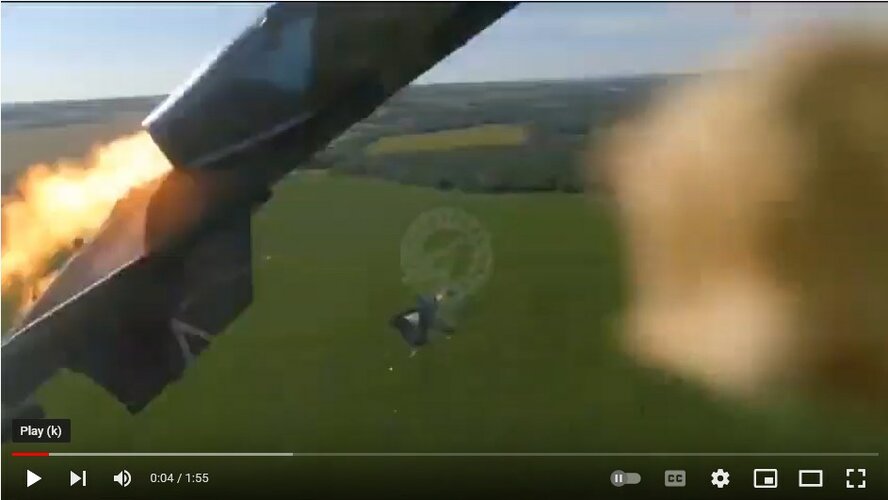
- Joined
- 6 November 2010
- Messages
- 5,263
- Reaction score
- 5,515
Earlier thread here: https://www.secretprojects.co.uk/th...from-the-pilot-perspective.40367/#post-559404
Powerline strike near Belgorod, in June, according to latest reply by hagaricus.
Powerline strike near Belgorod, in June, according to latest reply by hagaricus.
- Joined
- 22 January 2006
- Messages
- 4,216
- Reaction score
- 2,016
MergedEarlier thread here: https://www.secretprojects.co.uk/th...from-the-pilot-perspective.40367/#post-559404
Powerline strike near Belgorod, in June, according to latest reply by hagaricus.
I always had a feeling power lines were sort of flimsy and an impact of an object weighing a few tens of kilos would be enough to snap them. Guess not.The single frame that shows the aircraft with some clarity shows that the vertical stabilizer was sliced off cleanly. This supports the story that the plane hit a power line.
View attachment 686183
You'd think that a ground attack plane in the same class as the A-10 would be pretty substantially armored. But maybe SU-25 armor is the same stuff Russian body armor and helmets are made from...I always had a feeling power lines were sort of flimsy and an impact of an object weighing a few tens of kilos would be enough to snap them. Guess not.The single frame that shows the aircraft with some clarity shows that the vertical stabilizer was sliced off cleanly. This supports the story that the plane hit a power line.
View attachment 686183
Kat Tsun
eeeeeeeeeeeeeee
- Joined
- 16 June 2013
- Messages
- 1,371
- Reaction score
- 1,778
You'd think that a ground attack plane in the same class as the A-10 would be pretty substantially armored. But maybe SU-25 armor is the same stuff Russian body armor and helmets are made from...I always had a feeling power lines were sort of flimsy and an impact of an object weighing a few tens of kilos would be enough to snap them. Guess not.The single frame that shows the aircraft with some clarity shows that the vertical stabilizer was sliced off cleanly. This supports the story that the plane hit a power line.
View attachment 686183
Su-25 is just copying A-10's past glories: https://www.torch.aetc.af.mil/News/...underbolt-ii-to-crash-into-power-line-cables/
The Missouri National Guard strikes again. It's something of a meme that crashing expensive military hardware and MONG are an inseparable duo, I guess it must be the Everclear in the water. Of course, it helps that A-10 has two stabilizers, which is the only reason this was able to make it back to base because the right stabilizer was missing.
Sadly, its engine placement has resulted in battle losses to Iglas, something the Su-25 just kinda shrugs off, since its internal engine placement allowed installation of a titanium armored bulkhead after the Afghanistan War, of which we have video evidence for. A-10 thinks air is armor, so while I guess Rooks are designed to compensate for practical battlefield threats, the A-10s are designed for pilot incompetence threats.
I always had a feeling power lines were sort of flimsy and an impact of an object weighing a few tens of kilos would be enough to snap them. Guess not.The single frame that shows the aircraft with some clarity shows that the vertical stabilizer was sliced off cleanly. This supports the story that the plane hit a power line.
View attachment 686183
It depends on the power line really, but high tension, high voltage cables are generally speaking lethal and will cleave through aircraft structure pretty easily, especially at 200 knots. They're giant steel cables covered in insulation so they're not exactly "flimsy" unless you mean a household power line or something.
Practically speaking, it's a similar low altitude threat to a barrage balloon.
Last edited:
Conspirator
CLEARANCE: L5
- Joined
- 14 January 2021
- Messages
- 324
- Reaction score
- 230
my question is. what was the reason he was flying so low? he was clearly under 500m off the ground. which, it's common for this aircraft to do that on strike runs. But this was within Russia. No opposition. So just Pilot Error? (stupidity?)
You're in a ground attack platform designed to fly low. It's *fun* to fly low. It's the natural thing to do.my question is. what was the reason he was flying so low? he was clearly under 500m off the ground. which, it's common for this aircraft to do that on strike runs. But this was within Russia. No opposition. So just Pilot Error? (stupidity?)
Conspirator
CLEARANCE: L5
- Joined
- 14 January 2021
- Messages
- 324
- Reaction score
- 230
understandable. i would probably have done the same thing. but the pilot should have been more aware of the surrounding objects. and i believe this video just solidifies the fact that air warfare/accidents happen in the blink of an eye. no margin for error. It's kind of scary to think.You're in a ground attack platform designed to fly low. It's *fun* to fly low. It's the natural thing to do.my question is. what was the reason he was flying so low? he was clearly under 500m off the ground. which, it's common for this aircraft to do that on strike runs. But this was within Russia. No opposition. So just Pilot Error? (stupidity?)
Kat Tsun
eeeeeeeeeeeeeee
- Joined
- 16 June 2013
- Messages
- 1,371
- Reaction score
- 1,778
my question is. what was the reason he was flying so low? he was clearly under 500m off the ground. which, it's common for this aircraft to do that on strike runs. But this was within Russia. No opposition. So just Pilot Error? (stupidity?)
How do you expect a pilot to train to fly at low altitude without training to fight at low altitude?
understandable. i would probably have done the same thing. but the pilot should have been more aware of the surrounding objects.You're in a ground attack platform designed to fly low. It's *fun* to fly low. It's the natural thing to do.my question is. what was the reason he was flying so low? he was clearly under 500m off the ground. which, it's common for this aircraft to do that on strike runs. But this was within Russia. No opposition. So just Pilot Error? (stupidity?)
Well sort of. It would matter on a combat mission I suppose.
However this is quite often impossible to ask on fairly routine flights, which is why America has a thing called the Sonoran desert, which is devoid of low altitude obstacles and Russia uses parts of Siberia for similar purposes. I believe the UK has a flight training range where Strike Eagles can routinely be found, and my neighborhood where I live is often a turnaround point and nav marker for Apache and Blackhawk platoons. None of these places have especially high obstacles above about 20 meters, certainly not high tension power cables like the kind that straddle pylons about 30-50 meters in height, which is right in the fuzzy border realm of nap-of-the-earth where attack helicopters and ground attack aircraft like to zip around.
Hitting things is just something that happens and the good news is that the pilot evacuated his aircraft safely.
Perhaps he was showing off like OBB implies, but it would hardly be the first guy to do so, and at least this time he didn't hit a cable car or something. Hitting a power line is annoying but mostly forgivable by transferring to a staff or perhaps ancillary support position instead of a combat pilot position.
. Hitting a power line is annoying but mostly forgivable by transferring to a staff or perhaps ancillary support position instead of a combat pilot position.
Well, you just provided another valid reason why a Russian pilot might choose to fly really low. Prang a plane, get withdrawn from combat service. Darn.
,
Last edited:
Kat Tsun
eeeeeeeeeeeeeee
- Joined
- 16 June 2013
- Messages
- 1,371
- Reaction score
- 1,778
. Hitting a power line is annoying but mostly forgivable by transferring to a staff or perhaps ancillary support position instead of a combat pilot position.
Well, you just provided another valid reason why a Russian pilot might choose to fly really low. Prang a plane, get withdrawn from combat service. Darn.
You can say the same about any pilots in the US military from 1965-1972 lol. Ukraine isn't a very intense theater for aviators though. Russia has lost about as many planes as America did in Desert Storm in a similar amount of time, for instance. There's only two assault aviation regiments, both from the 4th Air Army in theater, although this guy might be from either of them given the location.
Anyway he can probably look forward to not having a career, nor much of a pension due to lack of career ascending prospects, and perhaps being liable for losing his plane by having his paycheck garnished. At least he keeps a job, provided it wasn't criminal negligence and merely an accidental loss. If he actually lost control or something, instead of just flying into a power line by accident, he might even still be qualified for flying, but you usually don't hit power lines accidentally unless your eyes are failing you. If he's liable for hijinks like pylon-storming , then he should be cashiered and put in prison for a long time.
That would all be the most moral outcomes, but it's likely he will simply continue his career for a few more years, be drummed out, and never get hired by an airline over this. That's the more typical outcome, which is unfortunate, because even after an accidental mishap a pilot can provide useful labor in a middle manager role, either in the armed forces or at a airline, without necessarily needing to lose out on his pension.
Last edited:
Do I need to explain in greater detail why exactly the now-deleted videos showing the quality of modern Russian armor are in fact utterly relevant to the discussion?
Mass of armor is not as important as *quality* of armor, especially for a vehicle like an aircraft that needs to watch its weight. You wouldn't think that this would be a controversial point to make, but here we are.
Mass of armor is not as important as *quality* of armor, especially for a vehicle like an aircraft that needs to watch its weight. You wouldn't think that this would be a controversial point to make, but here we are.
Kat Tsun
eeeeeeeeeeeeeee
- Joined
- 16 June 2013
- Messages
- 1,371
- Reaction score
- 1,778
Except Su-25 has actual video and photographic evidence of surviving Igla strikes, which are things that kill A-10:



All damaged by light shoulder fired missiles varying from Redeye to Blowpipe to Stinger. No one talks about MG A.V. Rutskoi's Su-25 loss to a Blowpipe over Afghanistan, much like no one dares question his moustache.
Unfortunately, because America has yet to fight Vietnam with its current military arsenal, so we're unlikely to see a war where two dozen A-10s are shot down by MANPADS to compare tabulated losses.
However, in the past 30 years the US has lost 7 A-10s in combat, of which 4 were lost to MANPADS-class warheads (Strela-2s, Strela-10, and Igla) in the 3-6 kg range, for a loss rate of ~57% to lightweight missiles. The rest were lost to unknown SAMs or Rolands.
Comparatively, Su-25's loss rate in Afghanistan suggests ~33% losses to MANPADS statistically, which is 23 confirmed lost aircraft with 21 confirmed shot down and 2 probable (CFIT or double counts), and 7 losses to MANPADS of those disclosed. Remainder of losses were due to Mujahideen attacks on airbases, not unlike Camp Bastion, F-16s, and random flak guns or whatever. Whether A-10 would iron that sad loss rate out with more losses is unknown of course, but there's plenty of reason to suspect it wouldn't due to the lack of armoring of the engine nacelles...
So Su-25 is either better protected against MANPADS or Soviet MANPADS are substantially more lethal against aircraft. Regardless, you'd clearly want to be in a Su-25 rather than an A-10 if you're destined to take a hit from a man portable missile. This is probably a good thing because Su-25 attracts more MANPADS and general ground fire than A-10 anyway.
Naturally there are cases where A-10 survived MANPADS, but these are fewer than Su-25, no one publishes engagement statistics (who knows what planes are shot at by, a 23mm cannon shell can look like a 14.5mm and a 30mm cannon can look like a Igla, etc.), and A-10 has barely seen combat action enough compared to Su-25, so it's all with a bit of salt. A hefty handful if you will. For an even more wild story there's supposedly a Su-25K that survived a MIM-23 hit, which is something A-10 would never be able to do, though.
tl;dr Yes I know it was a joking comment, but I find "sovtek stinky us tech good" to be about as trite as "4 shermans 1 tigger" tbh. It's so embedded in American popular consciousness that it's easily taken as serious at face value, and that sorta irks me rather than amuses me at this point, but I'm probably a tad jaded on that front. A-10 has hit power lines before, and it's not particularly different in outcome, except it has two stabilizers vice one. Which is the only reason the MONG Hog made it back to base in the first place. If the Su-25 had lost half its stabilizer it would still be flying.
Besides that, Rook has a more than proven, and arguably better, track record of surviving light man portable missiles than A-10.
Perhaps the most survivable and reasonably powerful ground attack hog would be something that combines A-10's H-tail with YA-9's engine placement (i.e. full isolation of nacelles), Su-25's internal armor system and beefy engines, and an electro-optronic nose with a ADEN 25 twin gun setup or a GAU-12/U in the belly.
Regardless, Su-25 isn't perfect, but it is much closer to the platonic ideal of an atomic age shturmovik than A-10. I suspect many of the combat losses of A-10 to relatively middling threats like Igla/Strela are due to asymmetric thrust developing from the widely spaced nacelles, where even if they survive the missile strike, there isn't enough stabilizer left to trim out the thrust. Centralized thrust solves this for the most part.
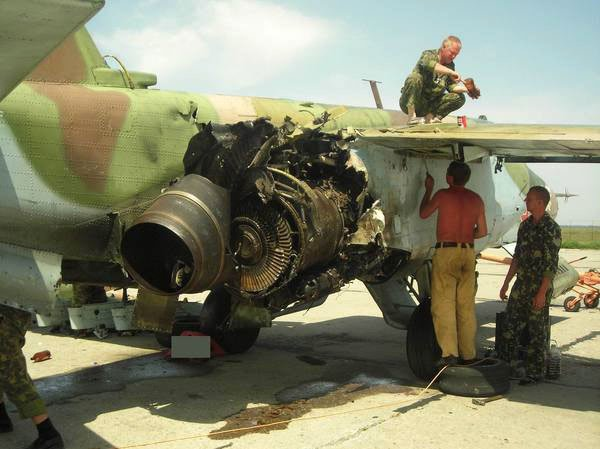
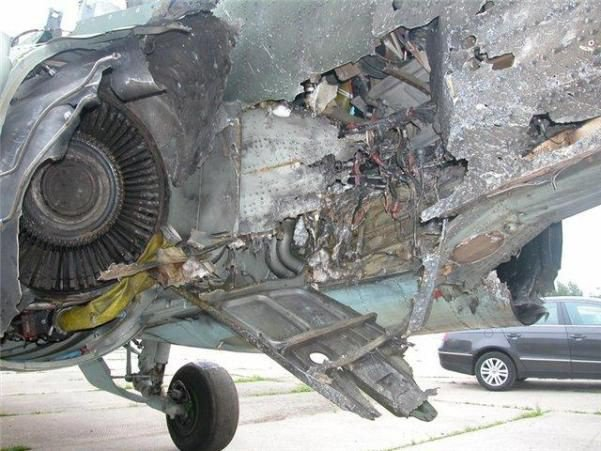
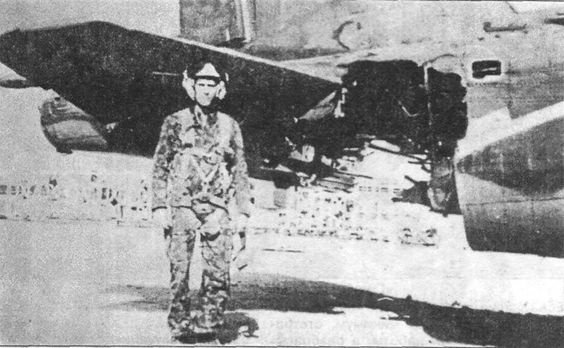
All damaged by light shoulder fired missiles varying from Redeye to Blowpipe to Stinger. No one talks about MG A.V. Rutskoi's Su-25 loss to a Blowpipe over Afghanistan, much like no one dares question his moustache.
Unfortunately, because America has yet to fight Vietnam with its current military arsenal, so we're unlikely to see a war where two dozen A-10s are shot down by MANPADS to compare tabulated losses.
However, in the past 30 years the US has lost 7 A-10s in combat, of which 4 were lost to MANPADS-class warheads (Strela-2s, Strela-10, and Igla) in the 3-6 kg range, for a loss rate of ~57% to lightweight missiles. The rest were lost to unknown SAMs or Rolands.
Comparatively, Su-25's loss rate in Afghanistan suggests ~33% losses to MANPADS statistically, which is 23 confirmed lost aircraft with 21 confirmed shot down and 2 probable (CFIT or double counts), and 7 losses to MANPADS of those disclosed. Remainder of losses were due to Mujahideen attacks on airbases, not unlike Camp Bastion, F-16s, and random flak guns or whatever. Whether A-10 would iron that sad loss rate out with more losses is unknown of course, but there's plenty of reason to suspect it wouldn't due to the lack of armoring of the engine nacelles...
So Su-25 is either better protected against MANPADS or Soviet MANPADS are substantially more lethal against aircraft. Regardless, you'd clearly want to be in a Su-25 rather than an A-10 if you're destined to take a hit from a man portable missile. This is probably a good thing because Su-25 attracts more MANPADS and general ground fire than A-10 anyway.
Naturally there are cases where A-10 survived MANPADS, but these are fewer than Su-25, no one publishes engagement statistics (who knows what planes are shot at by, a 23mm cannon shell can look like a 14.5mm and a 30mm cannon can look like a Igla, etc.), and A-10 has barely seen combat action enough compared to Su-25, so it's all with a bit of salt. A hefty handful if you will. For an even more wild story there's supposedly a Su-25K that survived a MIM-23 hit, which is something A-10 would never be able to do, though.
tl;dr Yes I know it was a joking comment, but I find "sovtek stinky us tech good" to be about as trite as "4 shermans 1 tigger" tbh. It's so embedded in American popular consciousness that it's easily taken as serious at face value, and that sorta irks me rather than amuses me at this point, but I'm probably a tad jaded on that front. A-10 has hit power lines before, and it's not particularly different in outcome, except it has two stabilizers vice one. Which is the only reason the MONG Hog made it back to base in the first place. If the Su-25 had lost half its stabilizer it would still be flying.
Besides that, Rook has a more than proven, and arguably better, track record of surviving light man portable missiles than A-10.
Perhaps the most survivable and reasonably powerful ground attack hog would be something that combines A-10's H-tail with YA-9's engine placement (i.e. full isolation of nacelles), Su-25's internal armor system and beefy engines, and an electro-optronic nose with a ADEN 25 twin gun setup or a GAU-12/U in the belly.
Regardless, Su-25 isn't perfect, but it is much closer to the platonic ideal of an atomic age shturmovik than A-10. I suspect many of the combat losses of A-10 to relatively middling threats like Igla/Strela are due to asymmetric thrust developing from the widely spaced nacelles, where even if they survive the missile strike, there isn't enough stabilizer left to trim out the thrust. Centralized thrust solves this for the most part.
Last edited:
Forest Green
ACCESS: Above Top Secret
- Joined
- 11 June 2019
- Messages
- 9,530
- Reaction score
- 17,486

HOW THIS A-10 WAS ABLE TO RTB AFTER HER RIGHT ENGINE HAD BEEN STRUCK BY AN IRAQI SAM [TODAY THE AIRCRAFT'S DAMAGED COWLING IS ON DISPLAY AT THE NATIONAL GUARD MUSEUM]
HOW THIS A-10 WAS ABLE TO RTB AFTER HER RIGHT ENGINE HAD BEEN STRUCK BY AN IRAQI SAM [THE AIRCRAFT'S COWLING IS AT THE NATIONAL GUARD MUSEUM]
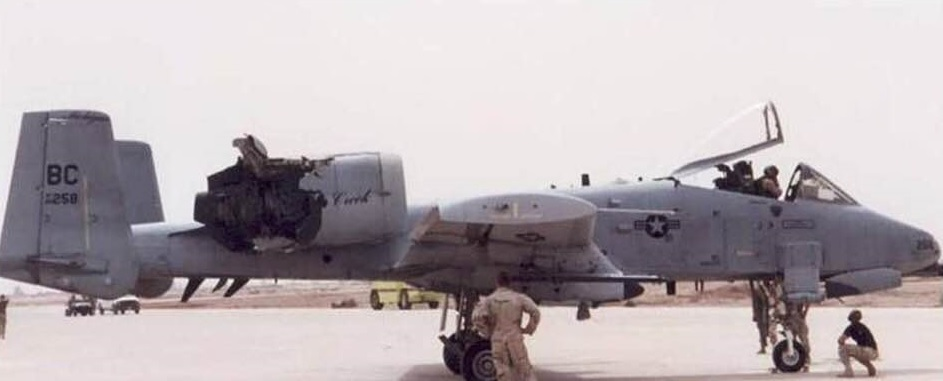
A-10 Survivability at the Cradle of Aviation Museum
The A-10A airplane was designed from its inception to a complete set of survivability requirements. As a consequence it incorporates over 100 features which significantly reduce its vulnerability not only to weapons that have been responsible for so many combat losses in past conflicts but also...
Do I need to explain in greater detail why exactly the now-deleted videos showing the quality of modern Russian armor are in fact utterly relevant to the discussion?
Did they, though? I'm not an expert on the subject, but bullet or shrapnel impact (which is what the armour is supposed to resist) seems different enough from bending the plate over your knee that I question the pertinence of that "test". In a synthetic polymer fiber vest, the protective material, removed from the context of the armour, could be deformed by flicking it with your finger... hell, it deforms under its own weight!
Last edited:
Kat Tsun
eeeeeeeeeeeeeee
- Joined
- 16 June 2013
- Messages
- 1,371
- Reaction score
- 1,778
One time I hit a SAPI plate with a hammer and it broke.
Worthless American junk. Clearly would never stop a bullet.
The fact that it is in a museum for something as banal as surviving an Igla, something four of its cousins didn't, is rather telling...
How many Su-25 gate guardians proudly display their battle damage from Blowpipes or Redeyes? None, because it's not something worth talking about. Eating a man portable missile is a casual Tuesday for a Rook driver.
Why does an A-10 deserve a museum for a damaged nacelle? How many A-10s display their battle damage from machine guns or AKMs? Probably none. Is that why this one is in a museum? Because it's so rare for them to come back from missile hits? Perhaps because their widely dispersed and highly offset from centerline nacelles combined with the close proximity of the vertical stabilizer makes corrective actions difficult? Because it was a highly challenging flight for the pilot to maintain control with an engine destroyed and being lucky enough to retain his starboard stabilizer to give sufficient corrective yaw to maintain control? Possibly.
What the pilot did in an aircraft which is inferior to protection against man portable missiles and engine-out situations is impressive, but it doesn't have to be, and it arguably shouldn't be. A-10 is just bad to fly if you lose an engine and worse if you lose an engine and a stabilizer. Su-25 can fly with two damaged nacelles because its engines are buried in the fuselage and protected by a titanium armor bulkhead. If one engine dies, the other is fine, and the stabilizer is above them and unlikely to be hurt.
That's the implication at least. Whether it's intended or not is an open question, but at least we have more evidence of Su-25s surviving Iglas and whatnot, and actual video evidence to back it up, whereas A-10 has several magazine articles and a museum display.
Worthless American junk. Clearly would never stop a bullet.

HOW THIS A-10 WAS ABLE TO RTB AFTER HER RIGHT ENGINE HAD BEEN STRUCK BY AN IRAQI SAM [TODAY THE AIRCRAFT'S DAMAGED COWLING IS ON DISPLAY AT THE NATIONAL GUARD MUSEUM]
HOW THIS A-10 WAS ABLE TO RTB AFTER HER RIGHT ENGINE HAD BEEN STRUCK BY AN IRAQI SAM [THE AIRCRAFT'S COWLING IS AT THE NATIONAL GUARD MUSEUM]theaviationgeekclub.com
View attachment 686251
A-10 Survivability at the Cradle of Aviation Museum
The A-10A airplane was designed from its inception to a complete set of survivability requirements. As a consequence it incorporates over 100 features which significantly reduce its vulnerability not only to weapons that have been responsible for so many combat losses in past conflicts but also...www.cradleofaviation.org
The fact that it is in a museum for something as banal as surviving an Igla, something four of its cousins didn't, is rather telling...
How many Su-25 gate guardians proudly display their battle damage from Blowpipes or Redeyes? None, because it's not something worth talking about. Eating a man portable missile is a casual Tuesday for a Rook driver.
Why does an A-10 deserve a museum for a damaged nacelle? How many A-10s display their battle damage from machine guns or AKMs? Probably none. Is that why this one is in a museum? Because it's so rare for them to come back from missile hits? Perhaps because their widely dispersed and highly offset from centerline nacelles combined with the close proximity of the vertical stabilizer makes corrective actions difficult? Because it was a highly challenging flight for the pilot to maintain control with an engine destroyed and being lucky enough to retain his starboard stabilizer to give sufficient corrective yaw to maintain control? Possibly.
What the pilot did in an aircraft which is inferior to protection against man portable missiles and engine-out situations is impressive, but it doesn't have to be, and it arguably shouldn't be. A-10 is just bad to fly if you lose an engine and worse if you lose an engine and a stabilizer. Su-25 can fly with two damaged nacelles because its engines are buried in the fuselage and protected by a titanium armor bulkhead. If one engine dies, the other is fine, and the stabilizer is above them and unlikely to be hurt.
That's the implication at least. Whether it's intended or not is an open question, but at least we have more evidence of Su-25s surviving Iglas and whatnot, and actual video evidence to back it up, whereas A-10 has several magazine articles and a museum display.
Last edited:
Attend your next nearest gun show. There should be at least one vendor of body armor; they will have steel plates as well as kevlar. You will note that the steel plates are *far* thicker than was shown. What was shown was simple sheet metal, on the order of one mm thick: it'd be unlikely to stop a .22, never mind a normal military round.Do I need to explain in greater detail why exactly the now-deleted videos showing the quality of modern Russian armor are in fact utterly relevant to the discussion?
Did they, though? I'm not an expert on the subject, but bullet or shrapnel impact (which is what the armour is supposed to resist) seems different enough from bending the plate over your knee that I question the pertinence of that "test".
The helmet that was shown being pounded inverted was likely a plastic airsoft helmet, as the one feller was complaining about. And there are numerous videos of captured Russian tanks covered in reactive armor filled not with explosives but with rubber or cardboard.
Corners have been cut on a *massive* scale. If this has happened with the body armor for the soldiers and the protection for ground vehicles, why should we assume it *hasn't* happened for aircraft?
Similar threads
-
TAM GE-31, Tblisi's non-Russian Sukhoi Su-25? Which potential Western engine?
- Started by TinWing
- Replies: 5
-
-
-
-

